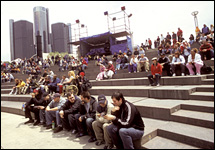MLUI / Articles from 1995 to 2012 / Never Easy, Never Dull
Never Easy, Never Dull
Learning to love Detroit’s sharp edges
June 19, 2005 |
Great Lakes Bulletin News Service
 | |
| MLUI/Bruce Giffin | |
Detroit's annual electronic music festival, held downton at Hart Plaza on Memorial Day weekend, reflects the city's surprisingly lively "underground" culture. |
I’m a city girl who grew up on Chicago’s South Side, a bus or “El” pass always tucked in my wallet. I lived in Washington, D.C., too, a few blocks from a Metro station. In other cities where I’ve lived, Portland and Minneapolis, I found housing that was tied to a decent bus or train route and no fewer than three coffee shops.
But when I moved to Detroit more than two years ago, it marked the first time I ever drove to a job. It was weird, the first of many distinctions that make Detroit and its suburbs so much different than anyplace else. But it was also perfectly normal to the people who grew to be my friends.
Knowing Enough To Want To Be Here
I knew something about Detroit before I got here. For one, it didn’t have a central gathering spot. The Campus Martius had yet to open downtown to large crowds. I knew that many of the big city offerings I’d taken for granted – gourmet groceries, a melting-pot of people, a carefree culture — were not the norm in Detroit. What was normal was rampant disinvestment in the urban core, older suburbs that try to be hip, and fast-growing new suburbs choking on traffic.
I also was aware, and became increasingly amazed at how race scars the region. White people warned me not to live in the city; nothing more than coded racial language. Friends in other parts of the country, aware of Detroit’s 1967 riot and lingering friction, had trouble fathoming my move to the Motor City.
It turns out, though, that Detroit and its older suburbs have endearing qualities that too often are overlooked, even misunderstood. For starters, the cost of living is affordable. The city is unapologetically gritty, and a subversive arts culture thrives in galleries, happy hours and storefront clubs.
You have to be creative and open-minded to infiltrate the social scene. But for an adventurous newcomer, the underground is a cultural treasure trove. Warehouse parties take place on weekends. Live music can be heard any night catering to virtually any genre. New lofts, carved out of old warehouses, are on the rise. Some of those same vintage buildings also are showcasing a new crop of visual artists. Many of the best restaurants are hidden jewels, naked to the superficial eye. Hot DJs are never far away.
Pragmatically speaking, casual dating as a young, black woman is, well, more fun than reading another book about “he’s just not that into you.” The East Coast pay-as-you-go dating mentality doesn’t flourish in Detroit. Here there are gentlemen, well-mannered, polite, respectful. In Detroit genteel South meets street-smart North. Then there are the quirks: this is the hair and alligator shoe capital of the country. Even city judges sport Mountain Dew-colored suits.
Friends Like It; Insurers Don't
I relish showing Detroit off to guests. A friend from New York recently visited not really knowing what to expect. She enjoyed the attention and pampering lavished by Detroit’s young men. She gaped at the grand architecture of Palmer Woods, one of the city’s nicest neighborhoods. We both found it neat to be in the place that birthed the most influential invention of the 20th century and created a musical soundtrack for a nation. We two policy wonkettes also spent a lot of time touring the neighborhoods and talking about the urban issues that other U.S. cities are tackling with more persistence than Detroit.
Though at times I risk sounding like I’m on the Detroit tourism board’s payroll, I am most decidedly not. For one, I ultimately chose to pay my rent in café-centric Royal Oak, outside the city. I feel poorly about this personal choice. But the economic case for living in Detroit is not strong enough yet.
It wasn’t the higher taxes that sealed the deal, but the car insurance, which would have tripled if I took residence two and a half miles south. Maybe I could’ve swallowed an inflated bill if riding to work on a bus or train were an option. It’s not. And there is so little social and political commerce between the city and its suburbs that metro Detroit area DINKS – double income, no kids – often feel that even if they did roll up their urban pioneer sleeves it’s not at all clear it would make a difference.
This Place Pulls Me
It does make a difference, though. For reasons that are plainly clear to me, and others that are purely instinct, I sense opportunity here. There is an urgency about the city and its suburbs, a social capital and entrepreneurial energy driven by real successes, especially the development of Mexicantown and East Jefferson, two of the city’s growing neighborhoods. People are out at night downtown, strolling the streets. During the day there is a buzz of construction activity.
This city’s elected leaders have joined their suburban counterparts in worrying about what’s in southeastern Michigan that will keep young people here. It’s a necessary cause of concern.The Detroit region lost more than 100,000 talented educated young adults during the 1990s, the highest rate of brain drain of any metropolitan area in the United States.
But in a strange way that’s why thousands more of us stay and like it here. We understand the urgency, the sharp edges. That’s something that Detroit can offer that is different than any other big city in the country. We feel needed.
Natalie Y. Moore, a former reporter with The Detroit News, is finishing a book on black masculinity in the hip-hop generation, Cleis Press, 2006. Reach her at nymoore@hotmail.com





